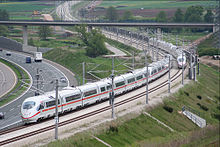Berlin–Palermo railway axis

TheBerlin–Palermo railway axis(German:Eisenbahnachse Berlin–Palermo,Italian:Asse ferroviario Berlino-Palermo) is project No. 1 of theTrans-European high-speed rail network(TEN-R), which involves the creation of a 2,200-kilometre-long (1,400 mi)high-speed railline betweenBerlinandPalermo.[1][2]It is designated as one of the main transport links connectingCentralandSouthern Europe,tracking throughGermany,AustriaandItaly.
Alignment and sections
[edit]From Berlin the line will run to theCentral German Metropolitan RegionofHalle/Leipzig,toErfurtand toSouthern GermanyatNuremberg,IngolstadtandMunich.Crossing the border with Austria, it will continue through the state ofTyrolalongKufstein,Wörgland the capitalInnsbruck.It will enter ItalianSouth Tyrol,passingFranzensfesteandBolzano,run throughNortheast ItalyviaVeronaandBologna,throughCentral ItalyalongFlorenceandRome,and reachSouthern ItalyatNaplesand finally shall ferry over toMessinaand Palermo onSicily.
Germany
[edit]
The corridor begins atBerlin Hauptbahnhofopened in 2006 and runs via the rebuiltAnhalt Railway(up toBitterfeld) andDessau–Leipzig railwaytoLeipzig Hauptbahnhof.The line shall continue toErfurt Hauptbahnhofon theErfurt–Leipzig/Halle high-speed railway,which opened in December 2015. Likewise, the southern continuation of this route along theNuremberg–Erfurt high-speed railwayopened in December 2017.
In the meantime, service is provided by tiltingICE Ttrains running on sections of theLeipzig–Großkorbetha railway,theThuringian Railway,and the windingSaal RailwayviaJena Paradies station,bypassing Erfurt on their way from Leipzig toNürnberg Hauptbahnhof.FromSaalfeld stationthey cross theRennsteigridge of theFranconian Forestvia theLeipzig–Probstzella railwayand theFranconian Forest Railwayand continue along theBamberg–Hof railway(fromHochstadt-Marktzeuln) and theNuremberg–Bamberg railway
Further to the south, the corridor runs via theNuremberg–Ingolstadt high-speed railwayline opened toIngolstadt Hauptbahnhofin 2006 and theIngolstadt–Munich linetoMünchen Hauptbahnhof.The following section of theMunich–Rosenheim railwayhas already been upgraded to four-tracks up toGrafing stationin order to separate mainline and suburban traffic. TheRosenheim–Kufstein railwaythat continues to the Austrian border andKufstein stationis proposed to get a bypass as part of theBrenner northern access.
Austria
[edit]
The heart of the Austrian section is theNew Lower Inn Valley railwaythrough theTyrolean Unterlandregion. In particular the section betweenWörglandBaumkirchenis the most congested line of the whole TEN-network, a result of the Austrian national east-west traffic and the international north-south traffic sharing the same line. The largest section fromKundlto Baumkirchen is already completed and in operation since December 2012. The shorter section between Kundl andKufstein(orBrannenburginBavaria), including a Wörgl bypass, is being planned. The Austrian section trains will be able to operate at up to 250 kilometres per hour (160 mph).
At the Baumkirchen rail hub, new high-speed curves link with theInnsbruck bypassincluding the Inn Valley tunnel (German:Inntaltunnel), which is already used by freight trains, but still needs to be upgraded for passengers and connected with the existingLower Inn Valley Railwayfor trains calling atInnsbruck Hauptbahnhof.The Inn Valley tunnel will connect directly with the futureBrenner Base Tunnel(Italian:Galleria di base del Brennero) bypassing the existingBrenner Railwayacross theAlpine divideup to the southern portal atFortezzainAlto Adige,Italy.Construction of the main bore on the Austrian side began on 19 March 2015. The combined Inn Valley and Brenner Base tunnels will be the longest railway tunnel in the world (62.8 kilometres (39.0 mi)).
Italy
[edit]
From the southern portal of the Brenner Base Tunnel at Fortezza, an upgrade of the 189 km (117 mi) long Brenner Railway section toVerona Porta Nuovais planned, bypassingBrixen/BressanoneandBolzano/Bozen.In the course of severalhigh-speed railprojects, the following lines have been built or significantly upgraded inItaly:
- In 2009 work was completed on duplicating theVerona–Bologna lineand upgrading it for 200-kilometre-per-hour (120 mph) speeds, including several deviations.
- TheMilan–Bologna high-speed line(215 kilometres (134 mi)) was opened on 13 December 2008.
- TheBologna–Florence high-speed line(78 kilometres (48 mi)) was opened on 13 December 2009.
- TheFlorence–Rome high-speed line(254 kilometres (158 mi)) was completed on 26 May 1992.
- TheRome–Naples high-speed linewas partially opened on 19 December 2005 and completely on 13 December 2009.
- TheNaples–Salerno high-speed linewas opened in June 2008.
Since the 2000s, aStrait of Messina BridgetoSicilyhas been proposed several times. In 2003, thesecond Berlusconi governmentannounced the construction of a combined rail/road bridge with a length of 3.3 kilometres (2.1 mi). The project was halted by a resolution of theChamber of Deputiesin October 2006,[4]resumed upon Berlusconi's re-election in 2008, and again discontinued in March 2013. In March 2023, theMeloni governmentresumed the project. On the mainland, an upgrade of the 400-kilometre (250 mi)Salerno–Reggio Calabria lineis also proposed to increase speeds and capacity. In Sicily, the long railway line fromMessinatoCatania CentraleandPalermo Centraleis being substantially upgraded to increase speeds and capacity.
EU coordinator
[edit]On 20 July 2005, the European Union appointed coordinators for the five major trans-European rail transport projects to accelerate the realisation of these projects. It appointed the BelgianKarel Van Miertto coordinate the Berlin–Palermo rail corridor, who upon his death in June 2009 was succeeded by the IrishPat Cox.
See also
[edit]- Main Line for Europe
- Scandinavian–Mediterranean Corridor
- Helsinki-Valletta Corridor
- Trans-European corridors
- Trans-European Transport Network
References
[edit]- ^"Trans-European Transport Network (TEN-T): selection of projects for the TEN-T multi-annual programme 2007-2013 and the annual TEN-T programme 2007"(Press release).European Union.21 November 2007.Retrieved12 February2019.
- ^"Map"(PDF).European Union.Retrieved6 February2010.
- ^"Special report: A European high-speed rail network".op.europa.eu.Retrieved2023-07-22.
- ^"Anas S.p.A. - Stretto di Messina SpA in liquidazione".Archived fromthe originalon 2014-12-07.Retrieved2014-12-05.
